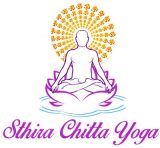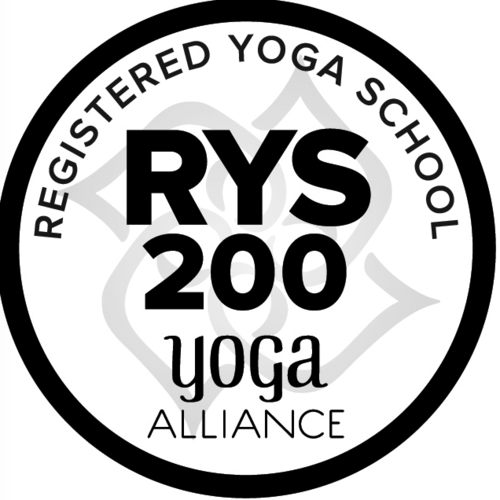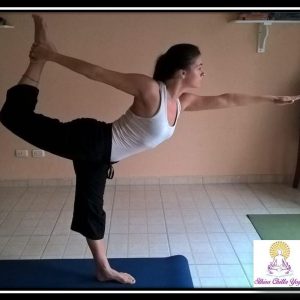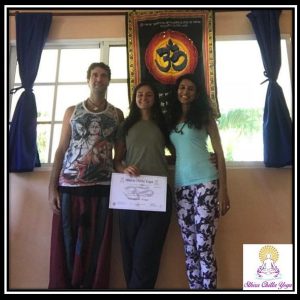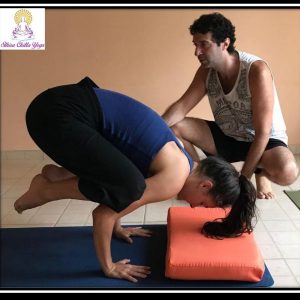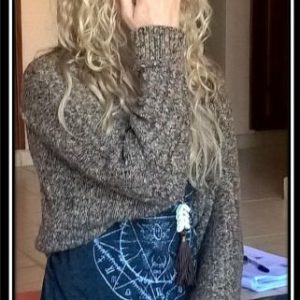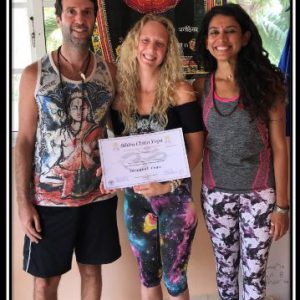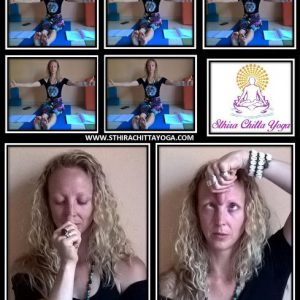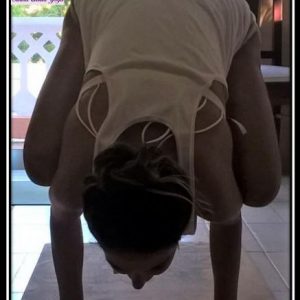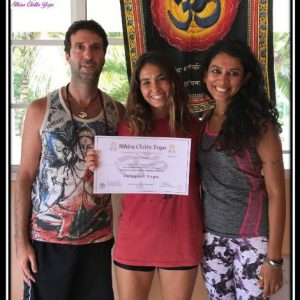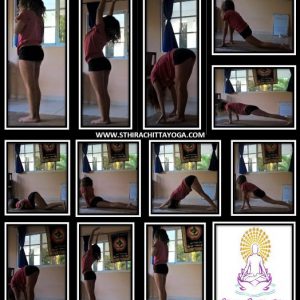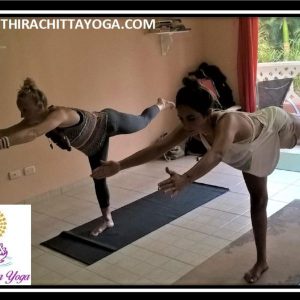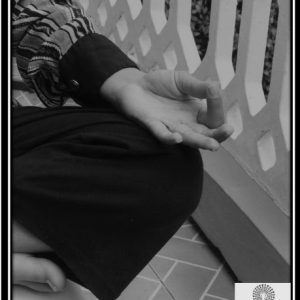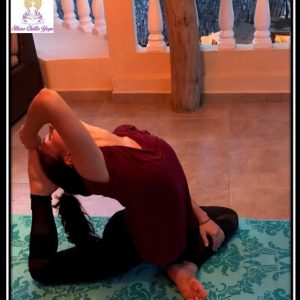The student will study and practice over 80 asanas (Hatha, Hatha Modified, Hatha Vinyasa & Flow)
SuryaNamaskar (Sun Salutation), ChandraNamaskar (Moon Salutation), SuryaNamaskar A & B (Ashtanga style)
Sukshma Vyayama
Series for Bones and Joint release
Pranayama (Breathing exercises & Traditional practices)
Shat Kriyas (Cleansing Techniques)
Mudras (Physical Gestures or Symbols) & Bandhas (Locks)
Focus on alignment using the (Iyengar style)
Focus on certain subtle practices aiming towards awakening Kundalini and Chakra cleansing.
The students will be able to learn the Sanskrit names of the Asanas with their English or Spanish equivalent names.
The method, limitations, benefits, common mistakes, modifications of the techniques and the alignment of each postures.
How to modify the Yoga techniques for different age and health conditions.
The Anatomy and Physiology of the Asanas and Pranayamas.
Application of the different Bandhas and Mudras in various practices.
Learn how to use props to ease in the posture, breathing in the postures.
Right Mental attitude whilst performing the posture, its connection to the mind and highlighting the overall spiritual dimension.
Focus on the 7 aspects of the Asanas (upwards, forward, backward, side, twist, balancing and inversion), the spiritual and energy flow in the practice of Sun Salutations, the importance of relaxation techniques and instructions will be performed.
Identification of key muscle groups and its functioning for increasing the flexibility and strength.
When we talk of Chakras we talk of the fullest potential in each and every individual. The Chakras represents the power of consciousness that lie within the range of each human.
The Chakras are the energy centers in our body, which can’t be seen even if you dissect the body. This is because Chakras are present in our Pranic body although one cannot see our Pranic body with naked eye either. But during your yogic practices you can bring your awareness onto these areas and experience their presence.
When there is an imbalance in our physical, mental and emotional state it affects the smooth functioning of the Chakras which in turn worsen this imbalance and we enter into this vicious cycle of imbalances and issues.
Hence to break this vicious cycle, allow balance in our life and proper circulation of Prana to the entire human structure. We need to activate, cleanse and balance these whirlpool of energy, our energy centers, our Energy Healings Chakras.
The aspirant will do this through the practice of various Asana, Pranayama & Mediation aiming at the particular Chakras. Which will be learn through lectures, practices and active demonstration.
Through daily deeper practices of Meditations, Mantras and Chanting the aspirant will work on increasing the purity and vibrations within and outside, creating a peaceful space within oneself and outside.
- The student will learn to deepen their practices through regular contemplation and chanting.
- Learn the principles of Meditations, details on when, how and who can do it and as a teacher how to guide others.
- Most of the practices will be based on the teachings of Classical Yoga and various Texts.
- Practices of Pratyahara (Control of Senses), Dharna (Concentration), Dhyana (Contemplation, Meditation).
- Some of the common practices of Yoga Nidra, Zen Meditation, different techniques from Tantra, Visualization, Guided Meditation, Chakra, Mandala etc.
- Student will learn to Chant certain Mantras and Sutras – Shanti Mantra, Beeja Mantras, Gayatri Mantras, etc.
- The techniques will aim at everyone including beginners, intermediate or advance practitioners.
Each student will need to demonstrate teachings of Asanas, Pranayamas, Kriyas, Meditation and a topic of Yoga Philosophy & Anatomy. The teaching will require designing the lesson plans and demonstrating in the class.
Along with this the student will be a part in the observation and evaluation for other student’s presentations.
This will train each student to be a more confident practitioner and teacher.
They will be able to gain first-hand experience of teaching.
The practical applications of all the techniques will help the student to recognize their weakness and strength and work on them accordingly. In the process of preparing for the class the student starts to study the topics in-depth hence it helps them to broaden their knowledge of the subject
Patanjali Yoga Sutras
Understanding the core of Bhagvad Gita, HathaYoga texts – Hatha Yoga Pradipika, Gheranda Samhita, Shiva Samhita.
Over View on the Tantra tradition, Vedas and Upanishads
Introduction to Samkhya Darsana
History and Background of Yoga
Different types of Yoga.
Various concepts Yoga
The base of the teachings will be – Ashtanga Yoga of Maharishi Patanjali (the eightfold path) and Samkhya Philosophy
Teachings of prominent Gurus & Yogis
Teaching of Yamas and Niyamas, different types of Yoga (Jnana, Karma, Bhakti), History and Background of Yoga and the various dimensions of Yoga. Understanding the four types of Bhavas and their applications through Asanas, etc. (Attitudes of duty, knowledge, awareness, objectivity, letting go and confidence etc.)
The student will be able to live the Yoga way of life through understanding the Yoga Philosophy and yogic concepts.
Students will gain the in-depth knowledge of the related Yoga Sutra and its application in practical life. They will learn how to impart the knowledge of Yoga Philosophy and how to teach the yogic concepts to their students. Through the understanding of the yogic concepts and connecting the mind with the body and breath they will be able to better their practices and teach the same. More over through the study of Karma Yoga, values and ethics of Yoga each student will be able to develop attitudes of Compassion, Friendliness, Selfless Work (Seva Bhav), etc.
The students will get an in-depth understanding of the Human Anatomy in connection of the Yoga techniques, required for becoming a better Yoga practitioner and teacher.
The knowledge and understanding of the different body systems:
1. Skeletal System
2. Muscular System
3. Digestive/Excretory System
4. Respiratory System
5. Cardio-Vascular/Circulatory System
6. Endocrine System
7. Nervous System
Understanding of the Body Organs, Energy Channels & Points.
How to connect the Anatomy Physiology to the Yogic practices.
Yogic techniques and their modifications for different ailments.
A deeper learning of the limitations and benefits of techniques. The physiological and spiritual connections of the Yogic techniques.
Yogic principles for healthy living.
The students will learn concept of disease and health in Ayurveda. Life from the Ayurveda point of view. The connection between the Living Beings and the Universe and the way of integrating these beautiful, ancient and natural sciences of Yoga and Ayurveda.
Introduction to Ayurveda
Basics of Ayurveda
PanchaMahabhuta (5 Elements)
PanchaKosha
Trigunas
Prakruti (Constitution)
Tri Doshas: Vata, Pita & Kapha (Humors)
SaptaDhatus (Body Tissues)
Dincharya (Daily Routines)
Different types of Agnis, its functions & location.
Ama (Toxins) & Trimala (The three body wastes)
Knowledge of Ayurveda in context to Diet, Nutrition and Disease management.
The student will learn the different therapeutic benefits from Yogic Concepts & Techniques for:
1. Bone & Joints disorder
2. Respiratory disorder
3. Hypertension & Cardiac
4. Weight Management
5. Menstruation disorders
6. Stress Management
7. Yoga for Senior Citizens
8. Yoga for Children
9. Health & Wellness
10. Role of Yoga in Health & Wellness
11. Balance, Joint Mobility, Mental Health, Flexibility & Wellness
12. Yogic concept of Health & Diseases
Human Psyche
Frustrations, Conflicts & Psychosomatic Disorders
Relationship between Mind & Body
Role of Yoga in Mental Hygiene
Mental Health : A Yogic perspective
Mudras, Mantras, Chanting & Meditation for Mental Health
Psychosocial Environment
Concept of Stress- A modern view
Role of Yoga in Stress & Lifestyle Management
- The word Teacher is associate with the one who wishes to impart the knowledge, skills and wisdom. The Teaching Methodology and Public Speaking sessions will help one polish their skills of imparting the knowledge to their students in the most effective and efficient manner.
- The student will learn how to use various teaching aids and different teaching methods for teaching various poses, their Alignments and teaching yogic concepts.
- The student will learn how to teach and demonstrate the different concepts and techniques of Yoga.
- Will learn variations & modifications of different techniques to be able to teach varied target audience.
- Usage of right voice modulations and communication skills to conduct a powerful teaching session for one to one teaching and group teachings.
- Studying different methodology of the same technique & concept, making it easy to practice and apply in teaching different level of students.
- The student will learn how to design a yoga session of 30 minutes to 90 minutes session of Hatha Yoga, Hatha Vinyasa & Flow, Meditation, and Pranayama sessions.
- The student will learn how to bring a flow and connectivity in the lesson plans of Yoga Philosophy.
- The student will be taught how to design and implement group programs.
- The student will teach at least one session (of techniques or concept) & learn how to give effective feedback.
- A deeper understanding of various different target audience, individual and groups teaching. Identifying your own style of teaching and sharpening your teaching skills by giving lessons plans.
- The student will be able to understand the opposite and demonstrate the teachings accordingly. Will be able to imbibe the qualities of a Yoga Teacher. Will gain confidence in teaching and will be able to create the correct sequence and flow of yogic techniques and concepts teachings.
Address: Cabarete, Puerto Plata, Dominican Republic.
WhatsApp / Phone: +34 662 07 88 55
Email: [email protected]

